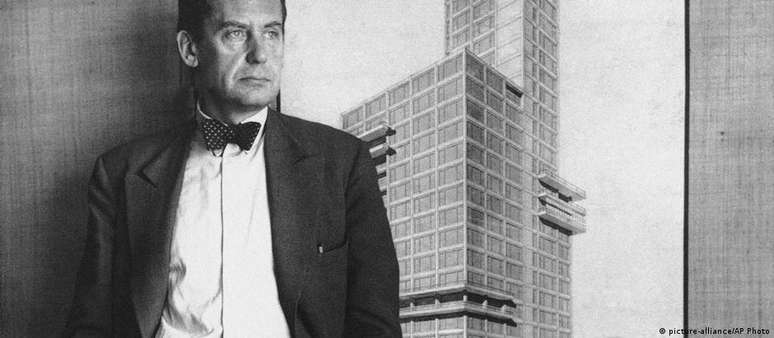On May 18, 1883, the German architect Walter Gropius was born, founder of the most important school of design and architecture of the 20th century, the Bauhaus. Best known as the father of the Bauhaus, an important and influential school that still characterizes design and architecture today, architect Walter Gropius had defined himself as an American since his forced emigration to the United States in 1937.
Coming from a traditional family from Braunschweig, Gropius was born in Berlin on May 18, 1883. When he came into the world, his great-uncle, Martin Gropius, had already built one of the most beautiful and famous buildings in the German capital, the exhibition space which today is known under the name of Martin Gropius Bau.
The foundation of the Bauhaus, in 1919, can be understood as a synthesis of the ideas that the architect had matured since his work with one of the forerunners of the modern movement, the architect Peter Behrens. In addition to Gropius, Le Corbusier and Mies van der Rohe worked in Behrens’ studio around 1910.
Overcoming the artistic dilemma
When he became the first director of the Weimar Bauhaus, a merger of the School of Applied Arts and the Saxon Academy of Fine Arts, Gropius brought with him, despite his young age, the best qualifications.
His experience in the Berlin studio of Behrens was fundamental in directing and fixing the didactic program of the school born to overcome the artistic dilemma in industrial and architectural production.
In Behrens’ office he had participated in the historic project for the electric company AEG, where industrial design was first introduced. It was not just an architectural project for the turbine factory, but the whole corporate design: from household appliances to stationery logos.
In 1910 Gropius opened his own architectural firm. Two major projects marked his production before the First World War. The 1911 Fagus factory in Alfeld/Leine, one of the first projects to use iron and glass in a modern way, and a factory project for the 1914 Werkbund exhibition in Cologne.
era of changes
In 1915 Gropius married Alma Mahler, former wife of the composer Gustav Mahler, from whom they separated eight years later. After the war, when Gropius returned as a highly decorated officer, he participated in the so-called November Group, the purpose of which was to absorb the impulses of the November 1918 revolution, which overthrew the monarchy in Germany. It was in this era of change that the Bauhaus was born.
The school emerged under the idea of ”big construction” and represented the current of the New Objectivity. His initial motto was to build the “cathedral of the future” or “cathedral of socialism”. Inspired by the constructions of medieval cathedrals, the Bauhaus sought to bring together arts and crafts to serve the society of the future, peaceful and without contradictions.
Industry interests
Gropius directed the Bauhaus until 1928. In the early days, his concepts were influenced by the idea of the “total work of art” propagated by composer Richard Wagner in the previous century, and by the overcoming of historical styles in art by transforming life in an aesthetic experience, popularized by the philosopher Friedrich Nietzsche. In its second phase, the Bauhaus soon succumbed to the interests of industry.
Accused of “Bolshevism” and “Judaism” by the conservative Weimar government, the school moved in 1925 to liberal Dessau, where Gropius designed his famous functionalist headquarters. Instead of the “cathedral of the future”, the Bauhaus’ initial motto, the school began to advocate the integration of art with technique.
Abandoned by trade unions and workers and persecuted by conservatives, Gropius found refuge and funding from industrialists. Form then followed function. However, politics did not fail to mark both the beginning and the end of the school, closed by the Nazis in 1933, who considered modernism “a communist thing”.
Functionalist and universalist principles
Fearing persecution, Gropius went into exile in England in 1934. The residential and school projects of the time, which he designed together with the English architect Maxwell Fry, greatly influenced local architecture.
In 1937, he accepted an invitation from the Harvard University School of Architecture in the United States. Gropius became director of the department in 1938, a position he held until 1952.
On the occasion of the 2nd Bienal de São Paulo, in 1953/54, Walter Gropius traveled to Brazil to be part of the jury of the architecture prize. The visit of the first director of the Bauhaus to Oscar Niemeyer’s Casa de Canoas did not please the Brazilian architect.
Precursor of functionalism and opponent of individualism in art, Gropius said to Niemeyer: “Your house is beautiful, but it cannot be multiplied”. In his writings, Niemeyer comments on the incident: “How can one speak of such stupidity with an air of seriousness? How can one multiply a house that adapts so well to the land?”.
Right or not, Gropius remained faithful to functionalist and universalist principles until his death on July 5, 1969. In addition to numerous projects in the United States and around the world, the German architect, who since his emigration to the United States at the age of 54 he declared himself American, he carried out important projects in Berlin.
These include the residential building for the Interbau architecture exhibition in 1957, the Bauhaus Archive building and a residential complex of 18,500 houses in the Neukölln district, which today bears the name of Gropiusstadt or Gropius City.
Source: Terra
Rose James is a Gossipify movie and series reviewer known for her in-depth analysis and unique perspective on the latest releases. With a background in film studies, she provides engaging and informative reviews, and keeps readers up to date with industry trends and emerging talents.





